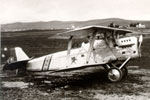| Valparaiso | |
|---|---|
 Vickers Valparaiso III in Portuguese service. | |
| General information | |
| Type | Light bomber |
| Manufacturer | Vickers |
| Primary users | Portugal |
| Number built | 28 |
| History | |
| First flight | 1923 |
| Retired | 1936 |
| Developed from | Vickers Vixen |
The Vickers Valparaiso was a British light bomber biplane of the 1920s. It was designed by Vickers as a development of its Vixen for export, being sold to Portugal and Chile.
